Sharon and I have both been to London before, have both seen all of the tourist sights we ever care to see, and had no deep-seated interest in spending piles of cash1 to kill time. Lazy walks suit us just fine, as does simply sitting about, chatting with friends, and cooking up a nice dinner. It was Melissa's birthday on 25 March, and I'd offered to cook up a nice meal to celebrate; if nothing else, it would keep me occupied while the Londoners were off at work during the day. We planned a dinner for six on Friday night, at Simon and Holly's place, where Sharon and I were staying.
We arrived in London at the crack of dawn on Thursday morning, with flurries all about the plane as we taxied to our gate. Neither Sharon nor I had slept particularly well on the flight over, so we didn't plan on doing much of anything that day. We met Melissa at her office, dropped off our luggage, and moseyed down to Borough Market to start the grocery shopping. The market recently started opening on Thursdays, which meant we could avoid the monstrous crowds of Friday and, even worse, Saturday, but only a quarter to a third of the stalls were occupied, so we didn't get the full experience.2
Borough is like a cross between a farmers' market and a grocery store. There were several butchers operating, a pair of fishmongers - one specializing in fish, the other in shellfish - a bakery, a cheese affineur, and several produce vendors, but there weren't any farmers selling local produce. Sure, it was late March, and it's hard to expect much produce then, even in the mild UK climate, but I'd hoped for something better. It was, in essence, just a grocery store with good-quality ingredients. Interesting, yes, and with plenty of good foods - meats, especially - to recommend it. But expensive, especially when it's difficult to see why lemons sold there should be any different from those sold in any grocery store.
It made me long for the purple "Local" tags that the Willy Street Co-op is so good about using.
But enough of that. We did pick up some fine ingredients, including wild mushrooms, pheasant, French raw milk cheeses, some wild boar sausages, and so on. The remaining odds and ends for dinner - flour, sugar, yeast, coconut milk, etc. - were easy enough to pick up at the Sainsbury's close to Simon and Holly's. Dinner, which had been roughly sketched out prior to our departure, had finally taken shape. I cooked all day Friday3 to prepare six courses for six, though we only had five4 at the table.
The menu was as follows:
The real trick of it all, of course, was attempting to pull this off in a stranger's kitchen. It's not that Simon and Holly don't cook - though he did remark, after dinner, something along the lines of, "Well, what do you know? It's actually possible to cook food in our kitchen!" - though they don't cook to quite the level I'm used to. They have a really lovely set of wooden cutting boards, but the knife selection was limited, especially for filleting the fish and dismembering the pheasant, and all of the pans were nonstick with plastic handles.5 I did find one measuring cup - graduated, for liquids - in metric, and Sharon was able to go online and help me do some conversions; the rest I simply fudged by eye.First Course
Chinese spoon with ginger-lime coconut milk pudding, candied ginger, and Thai-spiced peanuts
Second Course
Salad of Lollo Rosso lettuce and arugula with orange-white wine vinaigrette, poached egg, crouton, and raw milk goat cheese
Third Course
Seared and roasted pheasant breast with sauteed onion and wild mushrooms, orange-thyme spätzle, and black tea broth infused with star anise and blood orange
Fourth Course
Poached sea bass fillet with braised leeks, romanesco broccoli, and thyme flatbreads
Fifth Course
Phyllo rolls filled with roasted eggplant, roasted garlic, and basil, with coarse sweet pepper and garlic zhug
Sixth Course
Fresh whole-milk ricotta with raw milk cheese, blood orange segments, wine plumped-raisins, and white wine syrup
Given all that, it turned out surprisingly well. Note that the lighting in the dining room was quite low, and I didn't have a tripod, so the picture quality's a little, uh, poor.6 Dish by dish, here's how it came together:

Chinese spoon with ginger-lime coconut milk pudding, candied ginger, and Thai-spiced peanuts
No sense fooling about; the first course - just a little amuse-bouche - ought to be exciting. I'd come up with this idea after reading about puddings in the New York Times, and figured that coconut milk would bring a lot of flavor on its own. It's very rich, given that it's loaded with fat, so a bite or two really did the trick. It's just a range of the flavors I normally associate with Thai food, ramped up in intensity.
For an even more interesting version, I'd recommend trying this with palm sugar, and adding a dash of fish sauce or shrimp paste; a southeast Asian hot sauce could only be a good thing, as well. I used Penzeys' Bangkok Blend to season the peanuts, and you could certainly use more of that for more flavor. Just toss the chopped peanuts with a generous sprinkle of seasoning, using a few drops of oil, if necessary, to make sure it sticks.
Ginger-lime coconut milk pudding
IngredientsDirections
- One 14-ounce can coconut milk
- 1 tablespoon grated ginger
- Juice of two limes
- Zest of two limes
- 1 tablespoon sugar
- 1 teaspoon kosher salt
- 2 tablespoons cornstarch
- Candied ginger, chopped, to garnish
- Spiced peanuts, chopped, to garnish
- Shake the can of coconut milk thoroughly before opening, and pour into a small saucepan. Stir in the ginger, sugar, and salt, and bring slowly to just below a boil. Cover and allow to steep for at least twenty minutes.
- Create a slurry with the lime juice and cornstarch. Pour the slurry into the coconut milk mixture, whisking constantly to avoid lumps. Bring it all to a boil for a moment, then simmer for at least five minutes, still whisking.
- Remove from the heat and stir in the lime zest. Test for seasoning and adjust as necessary.
- Transfer to a bowl or serving dishes, cover tightly with plastic wrap, and refrigerate. If you don't like a skin on top, press the plastic directly on top of the pudding. Allow to refrigerate several hours, or overnight. It will continue to thicken as it cools.
- Serve with a sprinkling of candied ginger and spiced peanuts. The pudding will keep for several days in the refrigerator.
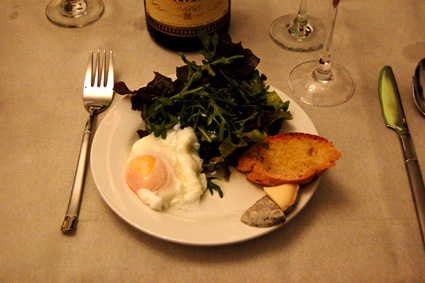
Salad of Lollo Rosso lettuce and arugula with orange-white wine vinaigrette, poached egg, crouton, and raw milk goat cheese
Sharon was an immense help here - and throughout the preparation and meal, I should add - preparing the greens while I poached eggs and toasted croutons. Between courses, I would return to the kitchen to cook the next, while Sharon cleaned any dishes we would need to reuse and offered a second set of hands. So, lest anyone think I can pull all of this off all by myself, take note.
There's nothing extraordinary about a salad, but the greens - reds, in the case of the lettuce - looked good, and more vegetables are always a good thing. And as I was looking for six courses that were impressive, but didn't require inordinate amounts of last-minute work, a salad was ideal. The original plan for the croutons had been to melt a little English cheddar on top until bubbling and brown, but the little cheeses we found at Borough Market were just too delicious. I didn't think that I could melt them and keep the qualities that made them so good, so I simply sliced and served alongside.
I'd also like to note: I took all of the least-pretty plates for myself. Thus this picture is the one ugly-looking poached egg of the bunch.
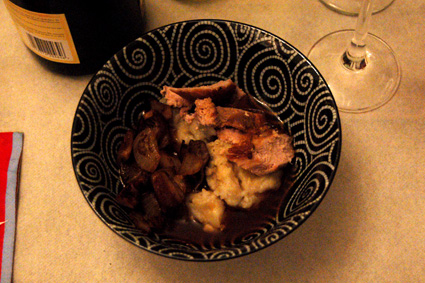
Seared and roasted pheasant breast with sauteed onion and wild mushrooms, orange-thyme spätzle, and black tea broth infused with star anise and blood orange
The original menu called for slices of duck breast with this dish, but we could only find them in pairs, meaning that there would have been far more meat than the modest little dumpling accompaniment I had in mind. Instead, we picked up a whole pheasant, and I removed the breasts for dinner. The legs, meanwhile, became the "staff lunch" for Sharon and I.
This dish was built around the idea of using tea somewhere in the meal. I toyed with it at home, and was pleased enough to run with it. It's a little unusual, and the broth was barely more than a sauce for the dish, but I like the way it works. It's also fun to pour the broth at the table; if I were at home, I'd use one of our cast-iron Japanese teapots, for a little style.
The spätzle, in this case, were good-sized dumplings, dropped off a spoon, but still remained rather delicate - moreso than the cheese gnocchi I'd also considered making. I was thrown for a loop when I couldn't find baking powder in the kitchen; a quick, fingers-crossed substitution of baking soda and freshly-squeezed orange juice managed to take care of things. It didn't, in the end, make a significant flavor difference, at least against the orange in the broth.
British mushrooms, which are a regular part of the typical British breakfast, are, I think, one of the numerous reasons the rest of the world makes fun of their cuisine. Sauteed just a little, they manage to find an odd middle ground between the firm texture of raw mushrooms and the soft texture and intensified flavor of fully sauteed ones. The texture's just a little firmer and spongier than canned mushrooms; they're wet with escaping moisture; and the flavor is raw mushroom without the freshness. Personally, I want some Maillard brown on there, with all that excess moisture cooked away to leave nothing but rich mushroom flavor. It didn't hurt that we picked up a nice range of wild mushrooms at the market - shiitake, two types of oysters, bluefoots, and chanterelles; the enoki, fairy rings, and porcini were tempting, too - and that they cooked with coarsely chopped onions until everything was browning and on the verge of crisping at the edges.
The pheasant I simply salted and seared, skin on, as best I could over high heat, then finished in a hot oven. I kept a hint of rosiness, just as I would for a duck breast. Sliced thinly, these laid across the top, to be drizzled with broth at the table.
The broth began with hot water and tea bags - three bags per two cups of water. Immediately, I added two whole star anise, the zest of an orange in big chunks, and let the whole thing steep, removing the tea bags after a few minutes. The star anise and orange lingered about for half an hour or so. Removing them, I added salt and the juice of the orange to taste, and thickened it with a little cornstarch. If you're feeling British, you could also thicken it with some cream, but I prefer the slight bitterness left in when it's not bound to milk proteins.
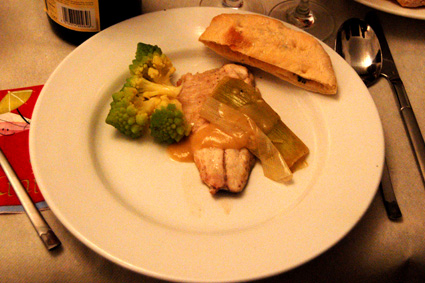
Poached sea bass fillet with braised leeks, romanesco broccoli, and thyme flatbreads
Braised leeks are easy, if messy. I'm used to relatively short leeks here, but the ones we found at the market in London were enormous batons. When possible, I'd recommend slicing the leeks in half along their lengths, in order to clean out any dirt, leaving the root end as close to intact as possible. This helps keep the various layers from drifting about in the braise. All you need to do is brown them well on both sides - cut side and, uh, the opposite - and simmer in liquid. In this case, it was a fish stock made from the heads and bones after removing the fillets. It takes about twenty minutes, and can be done ahead of time, if you'd prefer to simply rewarm the leeks in the liquid just before serving.
The fish poached in the liquid after removing the leeks, taking just a few minutes until the flesh went opaque and a knife slipped through without resistance. If there had been room, I'd've cooked the broccoli in there, as well, but I ended up cooking that in the leftover fish stock. Oven-roasting, just until the tips start to brown, would be another excellent preparation for broccoli.
If I'd had time, I would have made a real loaf of bread, but flatbreads taste almost as good and are remarkably easy. In fact, it's a general technique that I first started using while I was studying at Leeds, and continued with when Melissa and I shared a townhouse in college. When you would shape loaves from the dough, and allow for another rise as the oven warmed, you instead crank the oven to 450°F or higher. By hand or with a rolling pin, form general round shapes, thin like pizza crusts, and toss in the oven. A pizza stone works well, but simply laying them across the oven racks is fine. When they've puffed up and begun browning at the edges, they're ready. If you like a softer, more tender bread, err on the shorter side; if you like crisp, let them go a little longer. Do beware of steam escaping as they deflate - tongs are your friend.
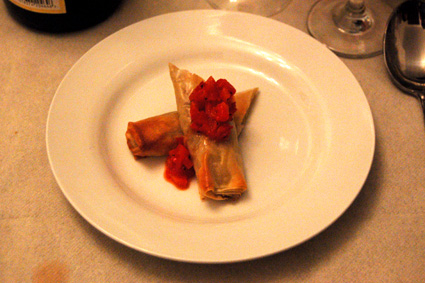
Phyllo rolls filled with roasted eggplant, roasted garlic, and basil, with coarse sweet pepper and garlic zhug
This was the one course that had nothing planned beforehand, except that I wanted either little packages or something crispy. At first, I'd thought that I could use wonton skins to make potstickers, but we couldn't find anything even close at the supermarket. Then, Sharon had the brilliant idea for phyllo, and it was perfect.
Roasting the eggplant and garlic produced some soft sweetness, paired with some fresh basil, which I just rolled up in the phyllo, not even bothering to close off the ends. Brushed with a little olive oil, they went in the oven until the edges were brown and crispy. Sliced diagonally, they stacked up nicely on the plate, topped with a little zhug.
Not that it was a real zhug, but I like the name. This was a roasted red pepper, skin removed, diced into small pieces, to which I added minced raw garlic, salt, pepper and olive oil. It was fresh and sharp, from the garlic, in contrast to the sweetness in the rolls, and the bright red looked quite good against the brown phyllo and white plates. If I'd remembered to add a little chiffonade of fresh basil, it would have looked even better.
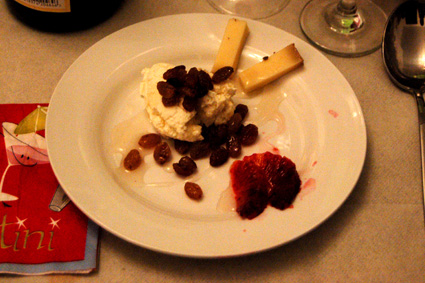
Fresh whole-milk ricotta with raw milk cheese, blood orange segments, wine plumped-raisins, and white wine syrup
When cooking in a new place, it's best to plan for unusual situations and, when possible, bring along all of the less-common things that you might need. Thus, I'd made sure to pack an instant-read thermometer,7 tongs, a microplane grater, and a few spices that I wasn't confident I'd find easily. Cheesecloth, silly me, I thought wouldn't be a problem.
When I asked Melissa where I might look to find some, on the off chance the grocery store didn't have any, she looked at me as though I'd asked where I might find fresh dinosaur eggs.8 Fortunately, she managed to come up with some cheap cotton dishtowels that did the trick, which was a real bonus, since I wasn't looking forward to using one of my t-shirts. That was my backup plan, but definitely a less than ideal one.
Early in the day, I created a simple syrup with equal parts white wine and sugar, and added in a fistful of raisins or two to plump up, bringing it just to a boil and then letting it all steep. Before serving, I took out the raisins and boiled the syrup until it ran off the spoon on a thick stream. The cheese was strained just before dinner, and simply salted.
To serve, I put a big spoonful of cheese on each plate, topped with some of the plumped raisins and a drizzle of the syrup. On the side were some cut segments of blood orange and another interesting cheese from Borough Market. I can't recall the name, but it was made from raw cow's milk, and not unlike the Bandaged Cheddar from Bleu Mont Dairy. I don't know that it necessarily went with the rest of dessert, but I liked it - and didn't want to go to the trouble of creating a full cheese course.
I then polished off the rest of the cheese as we sat around afterwards, finishing the last of the wine and digesting a bit before sleep.
* * * * *
1Prices in the UK are generally high, with a few exceptions. (Breakfast cereal comes to mind.) Add London-level premiums to that - much like spending more in New York City or Chicago for something that can be had more cheaply here in Madison. And then top it off with a spectacularly awful exchange rate.
2Sorry, but I didn't take pictures. Between juggling bags of meats and produce, jet lag, and low light levels, I didn't have the wherewithal to get going on that.
3After sleeping in, that is. Sharon and I hit up the grocery store first, and then I started cooking around 12:30pm, with dinner at 7-ish.
4James wasn't able to be there, as he was retrieving the houseboat he and Melissa had purchased, making the long, stomach-churning trip across the North Sea from the Netherlands. (More on that in the other London post.) So we saved him a little of everything, carefully packed for his triumphant return.
5In other words, getting good sear is nigh impossible, and pans can't go from the stove into the oven. These are issues that one can work around, but that take a little more stop-pause-think effort on my part.
6I refuse to use a flash unless absolutely necessary; I hate the flash about as much as I hate posed pictures. I feel that a flash flattens the image, eliminating texture and visual interest; posed pictures generally look fake to me, especially those with forced smiles.
7Why this isn't the sort of thing everyone has in a kitchen - I've got four or five, not counting chocolate and candy thermometers - is beyond me. Tongs, thermometers, and cast-iron cookware should be required equipment for everyone.
8Triceratops, preferably, but I'm not all that picky. Anything from the late Cretaceous would be just dandy.

No comments:
Post a Comment